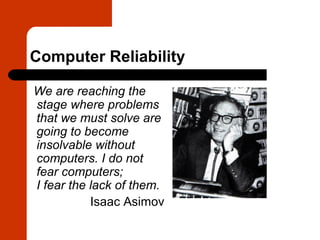
Reliability
- 1. Computer Reliability We are reaching the stage where problems that we must solve are going to become insolvable without computers. I do not fear computers; I fear the lack of them. Isaac Asimov
- 2. Are computers infallible? From sophisticated aerospace and military digital systems to simple word-processing and spreadsheet applications computer systems are subject to hardware malfunctions, software bugs (or defects: localized implementation errors) or communication failures.
- 3. Unreliable Hardware The Therac-25 case is the most striking incident of unreliable machines. Therac-25 was a computerised radiation therapy machine (used 1985 to 1987) caused six massive overdose due to system malfunctionherac-25 accidents are considered the worst in the history of medical accelerators.
- 4. Unreliable Software The Y2K bug (or Year 2000 bug) is the best-known example of software unreliability. In order to save computer disk space and memory, computer manufactures 60s to 80s designed date fields only two digits to represent a year four (‘86’ for ‘1986’).In early 90s computer programmers realised that year 2000 be interpreted by most software applications as 1900.
- 5. What is computer reliability? Computer reliability is defined as the ability of a computer system to perform its required functions for a given period of time. It includes the probability that the system will not fail during a given period of time.
- 6. Hardware Reliability Hardware reliability refers to the ability of a computer system to perform without errors. Hardware is unreliable when the computer system presents unwanted malfunctions or unpredictable breakdowns in its mechanical components.
- 7. Software Reliability Software reliability refers to the ability of a computer system to deliver its usable services when those services are demanded. An item of computer software is unreliable when the user’s expectations and demands are not fulfilled by the program.
- 8. Data Reliability Data reliability includes the following cases: (1) data security: the protection of data (physical and digital) must be kept confidential, safe, private and reliable; (2) data privacy: the access of data only by authorized persons; (3) data consistency: the correctness of data during processing (input, process, and output); (4) data integrity: the correctness of data both during and after processing is related to the accuracy of digital data with themselves and the correspondence of these data with the real world. A computer system lacks integrity when digital data do not correspond to the given information. Data may have changed either by accident or due to malicious purposes.
- 9. Principle of Discontinuity Where analogue systems are infinite state or continuous systems, digital systems are discrete state or discontinuous systems. Digital computers are discrete state devices with binary representations and instructions, a computer program may take so many different states that they cannot be tested or predicted. In complex systems, every change in the value of a variable may cause millions of effects in the whole system. All the possible states of the system cannot be absolutely tested or predicted.
- 10. Professional Responsibility Responsibility involves all the things for which an individual is considered to be accountable.
- 11. Role Responsibility Role Responsibility refers to the duties of an individual. Any role (teacher, doctor, parent, citizen) involves responsibilities. Role responsibilities are the individual obligations to behave in a proper manner (in accordance to the duties of the role).
- 12. Causal Responsibility Causal Responsibility refers to causality. According to the causal principle, every event has a cause so there is a causal nexus (a link) between a cause and its effect. Causal responsibility entails causal chain (a sequence of factors leading to a final effect) and it is related to both human and non-human factors.
- 13. Blameworthiness Blameworthiness refers again to causality but of the individual involved in the event. A person may be the cause of an event but not blameworthy for the situation.
- 14. Liability Liability refers to the accountability of an individual for an action or event. Liability involves legal matters; if a person is legally liable for a situation then this person is responsible even if is not blameworthy for the situation.
- 15. Forms of Responsibility There are two forms of responsibilities: (1) responsibilities concerning the computer professionals (computer systems may be unreliable due to hardware malfunctions, software defects or communication failures); (2) responsibilities concerning the individuals use the computer system consumers and end-users (computer systems are unreliable due to the user’s malpractice, misuse or negligence).
- 16. Possible Inadequacies Following the stages of a system life cycle as well as the ways that a computer system is applied, maintained and used the inadequacies may occur at: System Analysis System Design System Development System Testing System Installation Mismanagement Lack of Service Malpractice Misuse Negligence
- 17. IT Solution Computer professionals should provide fault-tolerant computer systems capable of providing either fail- safe or fail-soft protections. Fail-safe refers to the full functionality of a computer system despite the occurrence of a single fault, while fail-soft refers to the reduced functionality of a system despite the occurrence of a single fault. The latter is also known as the state of graceful degradation: a system continues to operate after a single fault but a reduced level.
- 18. Liability Solution The responsibility of a computer manufacturer has to be by particular policies and standards (rules, regulations and warranties). Any irresponsible action against these standards must be penalized. Supporters of strict liability maintain that such penalties will encourage responsibility of computer companies, enhance the quality of software and hardware production and legally protect the consumer from possible malfunctions.
- 19. Opponents Opponents of strict liability argue that the doctrine faces the following problems: applies only to physical harm or property; does not apply to services and complex systems that provide a combination of goods and services; it focuses only on the ultimate user. Strict liability requirements will raise the cost of development, testing and insurance. High costs will affect small computer companies and will reduce innovation and new software development.
